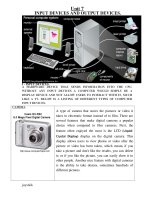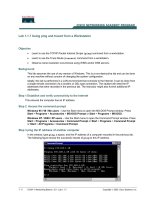Chap 7 measuring strengths and weaknesses
Bạn đang xem bản rút gọn của tài liệu. Xem và tải ngay bản đầy đủ của tài liệu tại đây (157.88 KB, 17 trang )
238 CHAPTER 7: Measuring Strengths and Weaknesses
Chapter 7
Measuring Strengths and Weaknesses
A. Intoduction
1. Meaning of Strengths and Weaknesses (TM 7-1)
B. Measuring Strengths and Weaknesses
1. Measuring of Product Strengths and Weaknesses: Conceptual Scheme (TM 7-2)
2. Meaning of Current Strategic Posture (TM 7-3)
• Operational Scheme For Measuring Current Strategic Posture (TM7-4)
• Current Strategy of a Product/Market (TM 7-5)
a. What Markets Do We Have? (TM 7-6)
b. How is Each Market Served? (TM 7-7)
3. Past Performance
• Product Performance Profile (TM 7-8)
• Market Performance Profile (TM 7-9)
• Financial Performance
a. Performance Measures (TM 7-10)
b. Performance Standards (TM 7-11)
4. Marketing Environment (TM 7-12)
C. Opportunity Analysis
1. Areas of Strength – Some Examples (TM 7-13)
2. Relative Strenghts of Personal Computer Firms in 2008 (TM 7-14)
3. Matching Strengths with Opportunities (TM 7-15)
4. Typical Marketing Weaknesses (TM 7-16)
239 CHAPTER 7: Measuring Strengths and Weaknesses
7-1
MEANING OF STRENGTHS AND
WEAKNESSES
Strengths refer to the competitive advantages and
other distinctive competencies that the company
can exert in the marketplace. The distinctive
competence of an organization is more than what it
can do; it is what it can do particularly well.
Weaknesses are constraints that hinder movements in certain directions.
CHAPTER 7: Measuring Strengths and Weaknesses 240
7-2
MEASUREMENT OF PRODUCT
STRENGTHS AND WEAKNESSES:
CONCEPTUAL SCHEME
241 CHAPTER 7: Measuring Strengths and Weaknesses
7-3
MEANING OF CURRENT STRATEGIC
POSTURE
• What underlies our company’s success, given
competitor’s patterns of doing business?
• Are there any characteristics and traits that have
been followed regularly?
• To what strategic posture do these characteristics and traits lead?
• What are the critical factors that could make a
difference in the success of the strategy?
• To what extent are critical factors likely to undergo a change? What may be the direction of
change?
CHAPTER 7: Measuring Strengths and Weaknesses 242
7-4
OPERATIONAL SCHEME FOR MEASURING
CURRENT STRATEGIC POSTURE
• Identify actual current scope of the company’s
activities.
• Identify pattern of actual past and existing
resource deployments.
• Deduce the actual basis on which the company
has been competing.
• Determine actual performance criteria, emphasis,
and priorities.
243 CHAPTER 7: Measuring Strengths and Weaknesses
7-5
CURRENT STRATEGY OF A
PRODUCT/MARKET
The current strategy of a product/market may be
examined by seeking answers to the following two
questions:
1. What markets do we have?
2. How is each market served?
CHAPTER 7: Measuring Strengths and Weaknesses 244
7-6
WHAT MARKETS DO WE HAVE?
• Recognize different market segments.
• Build a demographic profile of each segment.
• Identify important customers in each segment.
• Identify those customers, while important, also
do business with competitors.
• Reasons that each important customer may
have in buying the product from us.
• Strategic perspective of each important
customer as it concerns the product’s purchase.
• Anticipated changes in each customer’s
perspectives.
245 CHAPTER 7: Measuring Strengths and Weaknesses
7-7
HOW IS EACH MARKET SERVED?
It refers to the means that a company employs to
serve different customers. This can be examined
by analyzing information contained in Exhibit 7-3 in
the text. (See the breakfast cereal example in the
text.)
.
CHAPTER 7: Measuring Strengths and Weaknesses 246
7-8
PRODUCT PERFORMANCE PROFILE
CONTRIBUTION TO COMPANY
PERFORMANCE
Product
Line
Profitability
Product
Leadership
Technological
Growth
Support
of Total
Product
Line
Utilization of
Company
Resource
Provision
of
Customer
Benefits
247 CHAPTER 7: Measuring Strengths and Weaknesses
7-9
MARKET PERFORMANCE PROFILE
CONTRIBUTION TO COMPANY
PERFORMANCE
Market
Segment
Profitability
Market
Share
Growth
End-user
Markets
Size of
Customer
Base
Distribution
Strength
Degree of
Customer
Loyalty
CHAPTER 7: Measuring Strengths and Weaknesses 248
7-10
PERFORMANCE MEASURES
• Growth rate
• Profitability
• Market share
• Cash flow
249 CHAPTER 7: Measuring Strengths and Weaknesses
7-11
PERFORMANCE STANDARDS
• Company’s performance
• Competitors’ performance
• Management expectations
• Performance in terms of resource committed
CHAPTER 7: Measuring Strengths and Weaknesses 250
7-12
MARKETING ENVIRONMENT
Monitoring of the environment from the viewpoint
of products/markets is a line function that should
be carried out by those who are involved in making
marketing decisions. The constituents of the
product/ market environment are:
• Social and cultural effects
• Political influences
• Ethical considerations
• Legal requirements
• Competition
• Economic climate
• Technological changes
• Institutional evolution
• Consumerism
• Population
• Location of consumers
• Income
• Expenditure patterns
• Education
251 CHAPTER 7: Measuring Strengths and Weaknesses
7-13
AREAS OF STRENGTH—
SOME EXAMPLES
• Excellence in product design.
• Leadership in product innovation.
• Efficiency in customer service.
• Effectiveness in sales promotion.
• Merchandising efficiency.
• Customer loyalty.
• Dominant market share position.
• Effectiveness of advertising.
Dell
Hewlett-Packard
Apple
Lenovo
●
●
●
●
●
●
●
●
●
●
●
●
●
●
●
●
●
●
Service and Support
Retail Distribution
National Sales Force
Low-Cost Production
Financial Muscle
Depth of Management
Brand Name
Applications Software
Current Strengths
CHAPTER 7: Measuring Strengths and Weaknesses 252
7-14
RELATIVE STRENGTHS OF PERSONAL
COMPUTER FIRMS IN 2008
●
253 CHAPTER 7: Measuring Strengths and Weaknesses
7-15
MATCHING STRENGTHS WITH
OPPORTUNITIES
STRENGTH
Customer loyalty
LIKELY IMPACT
•
•
•
Cordial
relationships with
channels
•
•
•
•
•
OPPORUNTIY
(FURNISHED BY THE
ENVIRONMENT)
Incremental product
volume increases
Price increases for
premium
quality/service
New product
introductions
•
New product
introductions
Point-of-purchase
advertising
Reduction of
delivered costs
through distribution
innovations
Tied-in products
Merchandising
differentiation
•
•
•
•
•
•
•
A trend of changing
taste
An identified
geographic shift of
part of the market
A market segment
neglected by the
industry
A product-related
subconscious need
not solicited by
competition
A product weakness
of competition
A distribution
weakness of
competition
Technical feasibility
for improving
existing package
design
A discovered new
use for the product
or container
OBJECTIVES AND
GOALS
•
•
•
Develop a premium
product
Introduce the
existing product in
the segment hitherto
not served
Develop a new
channel outlet for the
product, etc.
CHAPTER 7: Measuring Strengths and Weaknesses 254
7-16
TYPICAL MARKETING WEAKNESSES
• Inadequate definition of customer for
product/market development.
• Ambiguous service policies.
• Too many levels of reporting in the organizational setup.
• Overlapping channels.
• Lack of top-management involvement in new
product development.
• Lack of quantitative goals.









